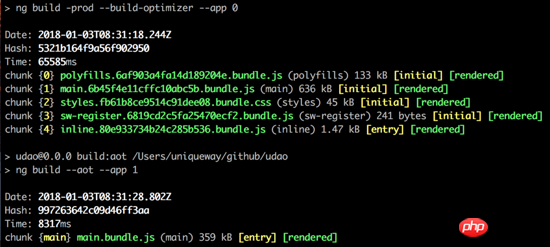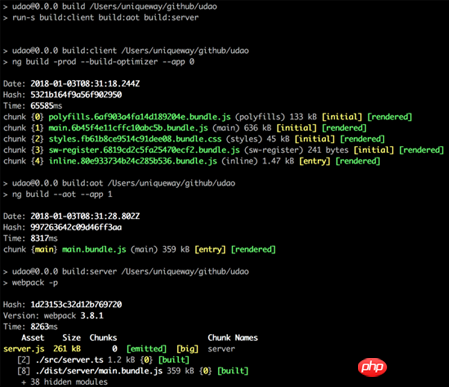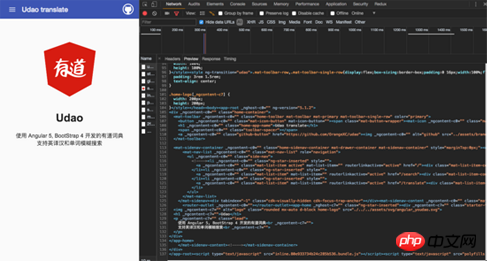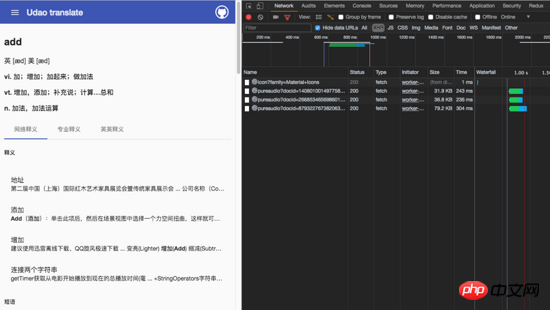
This article mainly introduces the detailed explanation of Angular5 server-side rendering practice. Now I share it with you and give it as a reference.
This article continues development based on the previous Angular5 article. The above article talks about the process of building Angular5 Youdao Translation and the solutions to the problems encountered.

Then the UI was changed from bootstrap4 to angular material. I won’t go into details here. Server-side rendering has nothing to do with modifying the UI.
Those who have read the previous articles will find that the content of the articles is biased towards server-side rendering, vue’s nuxt, and react’s next.
Before this revision, I also tried to find top-level packaging libraries like nuxt.js and next.js, which can greatly save time, but to no avail.
Finally decided to use the front-end and back-end isomorphic solution Angular Universal (Universal (isomorphic) JavaScript support for Angular.) that has been available since Angular2.
I will not introduce the document content in detail here. This article also Try to use easy-to-understand language to bring Angular's SSR
Prerequisite
The udao project written above is completely compliant with angular-cli, from construction to packaging , which also makes this article universally applicable to all angular5 projects built with angular-cli.
Building process
First install the server dependencies
yarn add @angular/platform-server express yarn add -D ts-loader webpack-node-externals npm-run-all
It should be noted here that the version number of @angular/platform-server is best based on the current Install the angular version, such as: @angular/platform-server@5.1.0 to avoid version conflicts with other dependencies.
Create file: src/app/app.server.module.ts
import { NgModule } from '@angular/core'
import { ServerModule } from '@angular/platform-server'
import { AppModule } from './app.module'
import { AppComponent } from './app.component'
@NgModule({
imports: [
AppModule,
ServerModule
],
bootstrap: [AppComponent],
})
export class AppServerModule { }Update file: src/app/app.module.ts
import { BrowserModule } from '@angular/platform-browser'
import { NgModule } from '@angular/core'
// ...
import { AppComponent } from './app.component'
// ...
@NgModule({
declarations: [
AppComponent
// ...
],
imports: [
BrowserModule.withServerTransition({ appId: 'udao' })
// ...
],
providers: [],
bootstrap: [AppComponent]
})
export class AppModule { }We need a master File to export the server module
Create the file: src/main.server.ts
export { AppServerModule } from './app/app.server.module'Now let’s update the configuration file of @angular/cli.angular-cli.json
{
"$schema": "./node_modules/@angular/cli/lib/config/schema.json",
"project": {
"name": "udao"
},
"apps": [
{
"root": "src",
"outDir": "dist/browser",
"assets": [
"assets",
"favicon.ico"
]
// ...
},
{
"platform": "server",
"root": "src",
"outDir": "dist/server",
"assets": [],
"index": "index.html",
"main": "main.server.ts",
"test": "test.ts",
"tsconfig": "tsconfig.server.json",
"testTsconfig": "tsconfig.spec.json",
"prefix": "app",
"scripts": [],
"environmentSource": "environments/environment.ts",
"environments": {
"dev": "environments/environment.ts",
"prod": "environments/environment.prod.ts"
}
}
]
// ...
}The //... above means omitting it, but there is no comment in json, which looks weird....
Of course, the configuration of .angular-cli.json is not fixed, and it depends on the needs. Modify by yourself
We need to create a tsconfig configuration file for the server: src/tsconfig.server.json
{
"extends": "../tsconfig.json",
"compilerOptions": {
"outDir": "../out-tsc/app",
"baseUrl": "./",
"module": "commonjs",
"types": []
},
"exclude": [
"test.ts",
"**/*.spec.ts",
"server.ts"
],
"angularCompilerOptions": {
"entryModule": "app/app.server.module#AppServerModule"
}
}Then update: src/tsconfig.app.json
{
"extends": "../tsconfig.json",
"compilerOptions": {
"outDir": "../out-tsc/app",
"baseUrl": "./",
"module": "es2015",
"types": []
},
"exclude": [
"test.ts",
"**/*.spec.ts",
"server.ts"
]
}Now You can execute the following command to see if the configuration is valid
ng build -prod --build-optimizer --app 0 ng build --aot --app 1
The running result should be as shown in the figure below

Then create the Express.js service and create the file: src /server.ts
import 'reflect-metadata'
import 'zone.js/dist/zone-node'
import { renderModuleFactory } from '@angular/platform-server'
import { enableProdMode } from '@angular/core'
import * as express from 'express'
import { join } from 'path'
import { readFileSync } from 'fs'
enableProdMode();
const PORT = process.env.PORT || 4200
const DIST_FOLDER = join(process.cwd(), 'dist')
const app = express()
const template = readFileSync(join(DIST_FOLDER, 'browser', 'index.html')).toString()
const { AppServerModuleNgFactory } = require('main.server')
app.engine('html', (_, options, callback) => {
const opts = { document: template, url: options.req.url }
renderModuleFactory(AppServerModuleNgFactory, opts)
.then(html => callback(null, html))
});
app.set('view engine', 'html')
app.set('views', 'src')
app.get('*.*', express.static(join(DIST_FOLDER, 'browser')))
app.get('*', (req, res) => {
res.render('index', { req })
})
app.listen(PORT, () => {
console.log(`listening on http://localhost:${PORT}!`)
})Of course you need a webpack configuration file to package the server.ts file: webpack.config.js
const path = require('path');
var nodeExternals = require('webpack-node-externals');
module.exports = {
entry: {
server: './src/server.ts'
},
resolve: {
extensions: ['.ts', '.js'],
alias: {
'main.server': path.join(__dirname, 'dist', 'server', 'main.bundle.js')
}
},
target: 'node',
externals: [nodeExternals()],
output: {
path: path.join(__dirname, 'dist'),
filename: '[name].js'
},
module: {
rules: [
{ test: /\.ts$/, loader: 'ts-loader' }
]
}
}For the convenience of packaging, it is best to add a few lines of scripts to package.json , as follows:
"scripts": {
"ng": "ng",
"start": "ng serve",
"build": "run-s build:client build:aot build:server",
"build:client": "ng build -prod --build-optimizer --app 0",
"build:aot": "ng build --aot --app 1",
"build:server": "webpack -p",
"test": "ng test",
"lint": "ng lint",
"e2e": "ng e2e"
}Now try to run npm run build and you will see the following output:

node Run the node dist/server you just packaged. js file
Open http://localhost:4200/ and the project main page will be displayed normally

It can be seen from the above developer tools that the html document is The server renders directly. Next, try to request data.
Note: None of the explicit (clickable menu) route initializations of this project request data, but the details page of word explanation will obtain data in the ngOnInit() method, for example: http:// A strange phenomenon will occur when localhost:4200/detail/add is opened directly. The request is sent once to the server and the client respectively. The request for the initialization data of the first screen of the normal server-side rendering project is executed on the server side and not twice on the client side. requests!
After discovering the problem, let’s eliminate this pit
Imagine if a mark is used to distinguish whether the server has obtained the data. If the data is not obtained, the client requests it. , do not send a request if the data has been obtained
Of course Angular has already prepared it, that is Angular Modules for Transfer State
So how to actually use it? See below
Request to fill in the pit
Introduce TransferStateModule at the server entrance and client entrance respectively
import { ServerModule, ServerTransferStateModule } from '@angular/platform-server';
// ...
@NgModule({
imports: [
// ...
ServerModule,
ServerTransferStateModule
]
// ...
})
export class AppServerModule { }
import { BrowserModule, BrowserTransferStateModule } from '@angular/platform-browser';
// ...
@NgModule({
declarations: [
AppComponent
// ...
],
imports: [
BrowserModule.withServerTransition({ appId: 'udao' }),
BrowserTransferStateModule
// ...
]
// ...
})
export class AppModule { }Take this project as an example in detail.component.ts and modify it as follows
import { Component, OnInit } from '@angular/core'
import { HttpClient } from '@angular/common/http'
import { Router, ActivatedRoute, NavigationEnd } from '@angular/router'
import { TransferState, makeStateKey } from '@angular/platform-browser'
const DETAIL_KEY = makeStateKey('detail')
// ...
export class DetailComponent implements OnInit {
details: any
// some variable
constructor(
private http: HttpClient,
private state: TransferState,
private route: ActivatedRoute,
private router: Router
) {}
transData (res) {
// translate res data
}
ngOnInit () {
this.details = this.state.get(DETAIL_KEY, null as any)
if (!this.details) {
this.route.params.subscribe((params) => {
this.loading = true
const apiURL = `https://dict.youdao.com/jsonapi?q=${params['word']}`
this.http.get(`/?url=${encodeURIComponent(apiURL)}`)
.subscribe(res => {
this.transData(res)
this.state.set(DETAIL_KEY, res as any)
this.loading = false
})
})
} else {
this.transData(this.details)
}
}
}The code is simple and clear enough, consistent with the principle described above
Now we only need to make small adjustments to the main.ts file to run our code when DOMContentLoaded, so that TransferState works normally:
import { enableProdMode } from '@angular/core'
import { platformBrowserDynamic } from '@angular/platform-browser-dynamic'
import { AppModule } from './app/app.module'
import { environment } from './environments/environment'
if (environment.production) {
enableProdMode()
}
document.addEventListener('DOMContentLoaded', () => {
platformBrowserDynamic().bootstrapModule(AppModule)
.catch(err => console.log(err))
})Go here and run npm run build && node dist/server.js and then refresh http://localhost:4200/detail/add to the console to view the network as follows:

It was found that no request was initiated in the XHR category, only the cache of service-worker was hit.
All the pitfalls have been overcome here. The project is running normally and no other bugs have been found.
Summarize
2018 The first article aims to explore the implementation of server-side rendering in all popular frameworks, and opens up angular, a framework that was not tried in the end.
Of course, Orange is still a front-end elementary school student. I only know how to implement it. The principles are not very clear, and the source code is not very clear. If there are any mistakes, I hope you can enlighten me.
The final Github address is the same as the previous article: https://github.com/OrangeXC/udao
The above is what I compiled for everyone. I hope it will be helpful to everyone in the future.
Related articles:
Detailed explanation of how to implement vuex (detailed tutorial)
Implement WeChat payment through vue.js
Implementing user permission control in Vue2.0
The above is the detailed content of Using Angular5 to implement server-side rendering practice. For more information, please follow other related articles on the PHP Chinese website!




